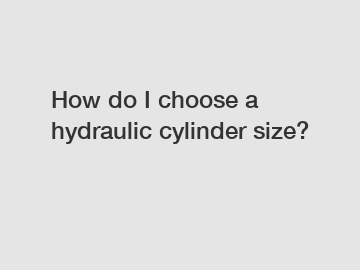How do I choose a hydraulic cylinder size?
How do I choose a hydraulic cylinder size?
When it comes to selecting the right hydraulic cylinder size, there are several factors to consider to ensure optimal performance and efficiency. This article will guide you through the process of choosing the appropriate cylinder size for your specific application. By following these guidelines, you can make an informed decision that meets your requirements effectively.
Understanding hydraulic cylinders.

Before diving into the selection process, it's important to have a basic understanding of hydraulic cylinders. These devices are used to create a linear force through the transfer of hydraulic fluid. They consist of a cylindrical tube, a piston, and a rod that extends from the cylinder.
Determining the required force.
The first step in choosing the correct hydraulic cylinder size is to determine the required force for your application. Consider factors such as the weight of the load or the force needed to push or pull an object. By calculating the required force, you can narrow down your options and choose a cylinder that meets your needs.
Measuring stroke length.
The stroke length refers to the total distance that the piston can travel inside the cylinder. It is crucial to measure the stroke length accurately, as it determines how far the cylinder can extend or retract. Consider the full range of motion required for your application and choose a cylinder with a stroke length that accommodates it.
Bore diameter and rod diameter.
Two essential dimensions to consider when selecting a hydraulic cylinder size are the bore diameter and rod diameter. The bore diameter is the internal diameter of the cylinder, while the rod diameter is the diameter of the piston rod. These dimensions directly affect the force output and stability of the cylinder.
Choosing the right bore diameter is crucial, as it plays a significant role in determining the force capacity of the cylinder. A larger bore diameter generally results in higher force output. However, it is important to consider the available space and the load requirements to avoid oversized cylinders.
The rod diameter also influences the cylinder's force capacity, but it primarily affects the stability and performance. A thicker rod provides higher stability and reduces the risk of rod deflection, ensuring smoother operation. Taking into account the load requirements and available space, choose a rod diameter that meets your specific needs.
Considering speed requirements.
The speed at which the hydraulic cylinder operates is another important factor to consider during the sizing process. The speed of the cylinder is determined by the flow rate of the hydraulic fluid. It is important to choose a cylinder size that can handle the required flow rate to achieve the desired operating speed efficiently.
Finalizing the selection.
After considering all the factors mentioned above, you should have a clear idea of the hydraulic cylinder size that suits your application. However, it is always recommended to consult with hydraulic experts or manufacturers to validate your selection and ensure that it aligns with your specific requirements.
Contact us for assistance.
In conclusion, choosing the right hydraulic cylinder size involves assessing the required force, stroke length, bore diameter, rod diameter, and speed requirements. By carefully considering these factors and seeking expert advice if necessary, you can ensure optimal performance and efficiency in your hydraulic system. For further assistance or to discuss your specific needs, don't hesitate to contact us. Our team of professionals is ready to assist you in selecting the perfect hydraulic cylinder size for your application.
For more customized skiving and roller burnishing machine manufacture, luffing cylinder, china one way hydraulic cylinders solutioninformation, please contact us. We will provide professional answers.
110
0
0


Comments
All Comments (0)